Deadly election protests have erupted in Tanzania, with the main opposition party alleging that over 500 people have been killed in three days.
Pan-Atlantic Kompass reports that the deadly election protests in Tanzania have plunged the country into chaos, leading to a military deployment, a night-time curfew, and a near-total internet shutdown.
The main opposition party, Chadema, which was barred from contesting the presidential poll alongside other major challengers, released a tally on Friday, claiming the nationwide figure for Tanzania election protest deaths is around 700.
The party spokesperson, John Kitoka, cited death counts from hospitals and morgues, noting that around 350 people were killed in the commercial hub of Dar es Salaam alone, with over 200 more in Mwanza.
“They are tracking down all our leaders and some have had to leave the country. These people kill with impunity,” Kitoka claimed.
But a government minister has defended the government’s handling of the unrest saying that “nobody can state how many were injured”.
Pan-Atlantic Kompass reports that demonstrations have been taking place in major cities, with young protesters denouncing the vote as unfair, as key opposition figures were barred from running against President Samia Suluhu Hassan.
Foreign Minister Mahmoud Kombo Thabit described what had happened as a “few isolated pockets of incidents here and there… our security forces acted very swiftly and decisively to address this situation”, he said.
“We are [also] continuing to receive the reports of the vandalised properties,” the minister said, adding that the internet blackout was necessary to stop such vandalism and save lives.
Also, Tanzania’s army chief, Gen Jacob John Mkunda, claimed that the demonstrators defied warnings.
“Some people went to the streets on 29 October and committed criminal acts. These are criminals and the criminal acts should be stopped immediately,” Gen Jacob John Mkunda said.
Meanwhile, the United Nations has reacted to the deadly election protests that erupted in Tanzania.
The United Nations on Friday urged Tanzania’s security forces to refrain from using unnecessary force against demonstrators and demanded investigations into election-related violence, after polls descended into deadly chaos.
“We are alarmed by the deaths and injuries that have occurred in the ongoing election-related protests in Tanzania,” office spokesman Seif Magango told reporters in Geneva, speaking from Nairobi.
“We call on the security forces to refrain from using unnecessary or disproportionate force, including lethal weapons, against protesters, and to make every effort to de-escalate tensions. Protesters should demonstrate peacefully.”
Magango said the internet appeared to have been widely restricted since Wednesday, without any official reasons being given.
He said the Tanzanian authorities should promptly reinstate access “and facilitate citizens’ full enjoyment of their rights to freedom of expression, association and peaceful assembly”.
“Curtailment of communication will only further undermine public trust in the electoral process,” he added.
The spokesman said the electoral campaigns had been “marred” by allegations of arbitrary arrests and detentions of opposition figures, including the opposition Chadema party leader Tundu Lissu, and reported enforced disappearances of people expressing dissenting views.
“All those in arbitrary detention must be immediately and unconditionally released and those held legally must be accorded full due process and fair trial rights,” said Magango.
“We urge the authorities to ensure prompt, impartial and effective investigations into all cases of election-related violence, and to ensure those responsible are brought to justice.”





